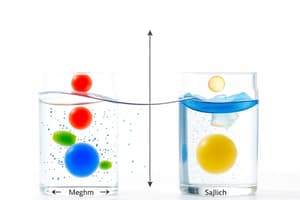Podcast
Questions and Answers
What is the Brønsted-Lowry definition of a base?
What is the Brønsted-Lowry definition of a base?
- A weak acid
- A proton donor
- A proton acceptor (correct)
- A strong acid
What does the Henderson-Hasselbalch equation help to calculate?
What does the Henderson-Hasselbalch equation help to calculate?
- The pKa of a strong acid
- The log of the acid dissociation equilibrium expression
- The pH of a solution containing a weak acid and its conjugate base (correct)
- The dissociation constant of a weak acid
When is a buffer most effective?
When is a buffer most effective?
- At a high pH
- At a pH equal to the pKa of the weak acid (correct)
- At a pH greater than the pKa of the weak acid
- At a low pH
What does the pKa of an acid indicate?
What does the pKa of an acid indicate?
What is the significance of the pKa value in the Henderson-Hasselbalch equation?
What is the significance of the pKa value in the Henderson-Hasselbalch equation?
Why is it important for inorganic phosphate to have multiple pKa values?
Why is it important for inorganic phosphate to have multiple pKa values?
How does the Henderson-Hasselbalch equation relate to the presence of a conjugate acid-base pair at a certain pH?
How does the Henderson-Hasselbalch equation relate to the presence of a conjugate acid-base pair at a certain pH?
Study Notes
Brønsted-Lowry Definition of a Base
- A Brønsted-Lowry base is a substance that accepts a proton (H+)
Henderson-Hasselbalch Equation
- Calculates the pH of a buffer solution
- Equation: pH = pKa + log ([conjugate base]/[acid])
Buffer Effectiveness
- Buffers are most effective when the pH is close to the pKa of the acid
- The buffer is able to resist changes in pH when there is a roughly equal concentration of the acid and its conjugate base
pKa of an Acid
- Indicates the acid's strength in a solution
- Lower pKa: Stronger acid
- Higher pKa: Weaker acid
pKa Significance in the Henderson-Hasselbalch Equation
- The pKa value in the Henderson-Hasselbalch equation represents the pH at which the concentrations of the acid and its conjugate base are equal
Inorganic Phosphate pKa Values
- Inorganic phosphate (H3PO4) has multiple pKa values because it can donate multiple protons in a stepwise fashion.
- Important for buffering within biological systems since it can act as a buffer over a broad pH range
Conjugate Acid-Base Pair and pH
- The Henderson-Hasselbalch equation demonstrates the relationship between the pH and the relative amounts of a conjugate acid-base pair
- When the pH is equal to the pKa, the concentrations of the acid and its conjugate base are equal
- As the pH increases, the concentration of the conjugate base increases relative to the concentration of the acid
- As the pH decreases, the concentration of the acid increases relative to the concentration of the conjugate base
Studying That Suits You
Use AI to generate personalized quizzes and flashcards to suit your learning preferences.
Related Documents
Description
Test your understanding of acid-base reactions, the Brønsted-Lowry definition, strong and weak acids, and the Henderson-Hasselbalch equation in the context of pH and buffers. This quiz covers material from Lecture 2 of BCMB 401, Spring 24, focusing on Chapter 1.3 of the reading.




